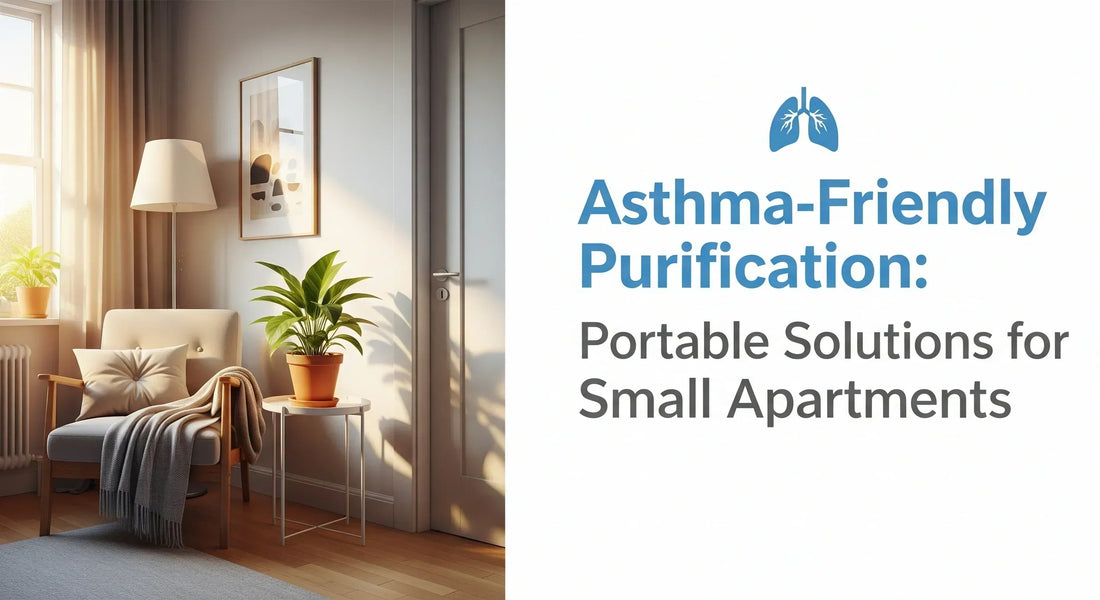
Asthma‑Friendly Purification: Portable Solutions for Small Apartments
Share
Living in a small apartment often means making smart choices about every square inch of space. When you’re managing asthma, those choices can feel even more critical. Dust, cooking smoke, cleaning chemicals and pollen quickly accumulate in confined areas, exacerbating asthma symptoms such as wheezing, coughing and tightness in the chest. Finding an air purification solution that supports respiratory health without dominating your living space can make a significant difference in daily comfort.
Understanding asthma triggers indoors
Asthma is a chronic respiratory condition characterized by inflamed airways and hypersensitivity to irritants. Indoors, common triggers include dust mites, pet dander, mold spores, volatile organic compounds (VOCs) from paints and cleaning products, and fine particulate matter from cooking or smoking. Even everyday activities like vacuuming or changing bed linens can stir up particles that linger in the air long after the task is done.
Because apartment living often concentrates these triggers within a smaller volume of air, the exposure levels can be higher than in larger homes. Limited ventilation can also slow the dispersal of pollutants. That’s why targeted air purification is important for asthma management in small spaces.
The case for portable air purifiers
Traditional tower purifiers are designed to clean entire rooms, but they can be bulky and may not fit comfortably into studios or one‑bedroom apartments. They also rely on HEPA filters that require regular replacement, adding to long‑term costs and generating waste. Portable purifiers offer a different approach by focusing on the immediate breathing zone rather than trying to handle all the air in a room.
Compact, filterless purifiers powered by photocatalytic oxidation technology neutralize pollutants at the molecular level. Instead of trapping particles in a filter, they use a catalyst activated by light to break down allergens, bacteria, viruses and odors into harmless components. This approach eliminates the need for filter changes and ensures consistent performance over time.
Benefits of small purifiers in apartments
- Space efficiency: A purifier with a footprint no larger than a drinking glass can sit unobtrusively on a nightstand, bookshelf or kitchen counter. It won’t crowd your living area or obstruct pathways.
- Personalized air cleaning: Placing a purifier near where you sleep, work or relax creates a zone of cleaner air right around you. This targeted strategy reduces asthma triggers exactly where they matter most.
- Low noise operation: Many portable purifiers are designed with quiet fans or fans that can be turned off, making them suitable for use in bedrooms, home offices or meditation corners.
- Energy efficiency: USB‑powered devices draw minimal power. You can plug them into a laptop, power bank or wall adapter, ensuring continuous purification without a noticeable impact on your electric bill.
- Portability: Their lightweight design means you can move them from room to room throughout the day. They’re as easy to transport as carrying a set of earbuds in a pocket or bag.
Key features to consider for asthma-friendly air purifiers
When choosing a purifier for asthma management in a small apartment, consider the following features:
- Filterless technology: Photocatalytic or electrostatic purifiers eliminate allergens without the need to replace filters. This reduces maintenance and helps maintain constant airflow.
- Coverage area: Ensure the purifier’s effective range matches the size of the space where you spend most of your time, whether it’s a desk, couch or bed.
- Ease of cleaning: Look for designs that allow you to wipe down components easily. Maintaining a clean device helps sustain performance.
- Adjustable settings: Some models allow you to choose between silent modes and more powerful settings, enabling you to balance noise and purification strength.
- Power options: USB and DC input flexibility means you can run the device from a variety of power sources, from a wall socket to a portable battery — perfect for renters on the move.
Practical tips for asthma‑friendly living
Beyond choosing the right purifier, there are several other ways to reduce asthma triggers in a compact living space:
- Minimize clutter: Clutter collects dust and makes cleaning more difficult. Keep surfaces clear and store items in closed cabinets or drawers.
- Regular cleaning: Vacuum carpets and soft furnishings with a HEPA filter vacuum. Use microfiber cloths to capture dust rather than scattering it.
- Control humidity: Maintain indoor humidity between 30 and 50 percent to discourage mold growth. A dehumidifier may be beneficial in humid climates.
- Ventilate when safe: When pollen counts are low, open windows to ventilate. Avoid doing this on high‑pollen days or during heavy traffic hours.
- Introduce low‑VOC products: Choose paints, cleaning supplies and furnishings labeled low‑VOC to reduce chemical irritants in the air.
Integrating a purifier into your routine
Living with asthma means constantly considering your environment. A compact purifier fits seamlessly into your daily life without overwhelming your decor, and it can be set up almost anywhere—even for travel or remote work at coworking spaces, cafes, or friends' houses. By neutralizing allergens and irritants at the molecular level, these devices help reduce asthma triggers while taking up minimal space. Keep it by your bed at night for cleaner air while you sleep, move it to your desk during work, or place it near cooking or cleaning activities to capture fumes and particles before they spread—just like carrying your favorite earbuds.
